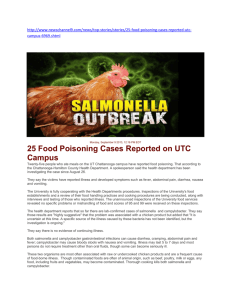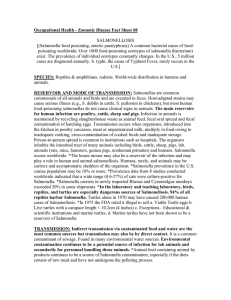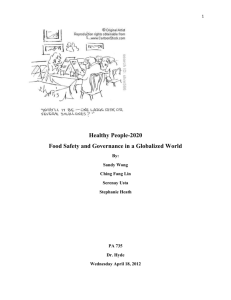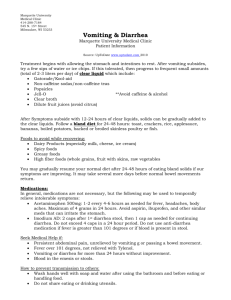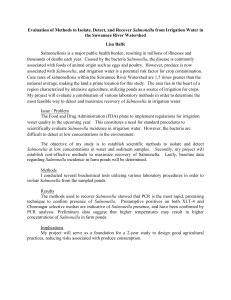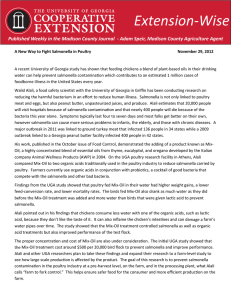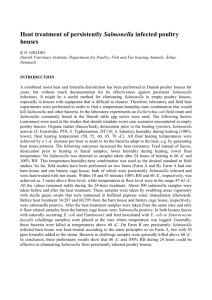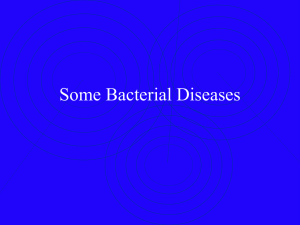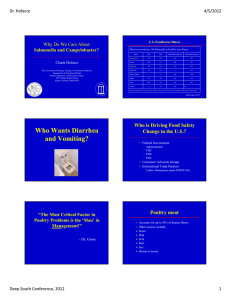SALMONELLOSIS
advertisement
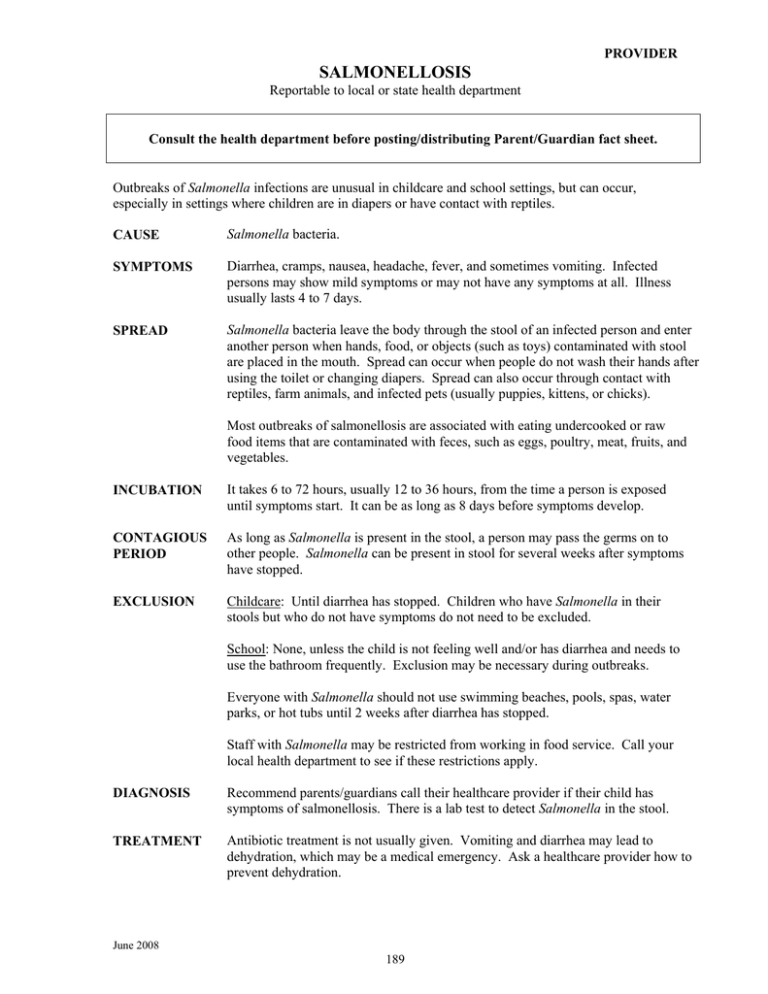
PROVIDER SALMONELLOSIS Reportable to local or state health department Consult the health department before posting/distributing Parent/Guardian fact sheet. Outbreaks of Salmonella infections are unusual in childcare and school settings, but can occur, especially in settings where children are in diapers or have contact with reptiles. CAUSE Salmonella bacteria. SYMPTOMS Diarrhea, cramps, nausea, headache, fever, and sometimes vomiting. Infected persons may show mild symptoms or may not have any symptoms at all. Illness usually lasts 4 to 7 days. SPREAD Salmonella bacteria leave the body through the stool of an infected person and enter another person when hands, food, or objects (such as toys) contaminated with stool are placed in the mouth. Spread can occur when people do not wash their hands after using the toilet or changing diapers. Spread can also occur through contact with reptiles, farm animals, and infected pets (usually puppies, kittens, or chicks). Most outbreaks of salmonellosis are associated with eating undercooked or raw food items that are contaminated with feces, such as eggs, poultry, meat, fruits, and vegetables. INCUBATION It takes 6 to 72 hours, usually 12 to 36 hours, from the time a person is exposed until symptoms start. It can be as long as 8 days before symptoms develop. CONTAGIOUS PERIOD As long as Salmonella is present in the stool, a person may pass the germs on to other people. Salmonella can be present in stool for several weeks after symptoms have stopped. EXCLUSION Childcare: Until diarrhea has stopped. Children who have Salmonella in their stools but who do not have symptoms do not need to be excluded. School: None, unless the child is not feeling well and/or has diarrhea and needs to use the bathroom frequently. Exclusion may be necessary during outbreaks. Everyone with Salmonella should not use swimming beaches, pools, spas, water parks, or hot tubs until 2 weeks after diarrhea has stopped. Staff with Salmonella may be restricted from working in food service. Call your local health department to see if these restrictions apply. DIAGNOSIS Recommend parents/guardians call their healthcare provider if their child has symptoms of salmonellosis. There is a lab test to detect Salmonella in the stool. TREATMENT Antibiotic treatment is not usually given. Vomiting and diarrhea may lead to dehydration, which may be a medical emergency. Ask a healthcare provider how to prevent dehydration. June 2008 189 SALMONELLOSIS PREVENTION/CONTROL • Wash hands thoroughly with soap and warm running water after using the toilet and changing diapers and before preparing or eating food. Thorough handwashing is the best way to prevent the spread of communicable diseases. Staff should closely monitor handwashing of all children after children have used the bathroom or have been diapered. • Chicks, ducklings, reptiles (e.g., pet turtles, iguanas, snakes), and amphibians are potential sources of Salmonella for small children and are not recommended for childcare settings. Wash hands thoroughly with soap and warm running water immediately after handling these pets. • Clean and disinfect diapering area and potty chairs after each use and bathroom toilets, sinks, and toys at least daily and when soiled. (See pgs 34-36.) • Clean and sanitize mouthed toys, objects, and surfaces at least daily and when soiled. (See pgs 34-36.) • Food Safety - - - - Thoroughly cook all foods that come from animals, especially poultry. Store all uncooked meat and poultry in the refrigerator on a shelf lower than any other foods and keep separate from produce, cooked foods, and ready-to-eat foods. DO NOT serve unpasteurized milk or juices. Use pasteurized eggs and milk in food that will not be cooked. Wash and disinfect all cutting boards, knives, utensils, or dishes that have been used for raw meat or poultry before using with uncooked foods, such as fruits or vegetables, or cooked foods. Use a thermometer to make sure correct temperatures are reached when cooking foods. Check with the local environmental health agency for appropriate tempatures. DO NOT allow children to serve or prepare food for others in the childcare or school setting. Discourage self-service food items in the school cafeteria (i.e., salad bars, trays of fruit, trays of desserts) and in the classroom. For more information, call your school nurse. Prepared by Hennepin County Human Services and Public Health Department (HSPHD) June 2008 190

